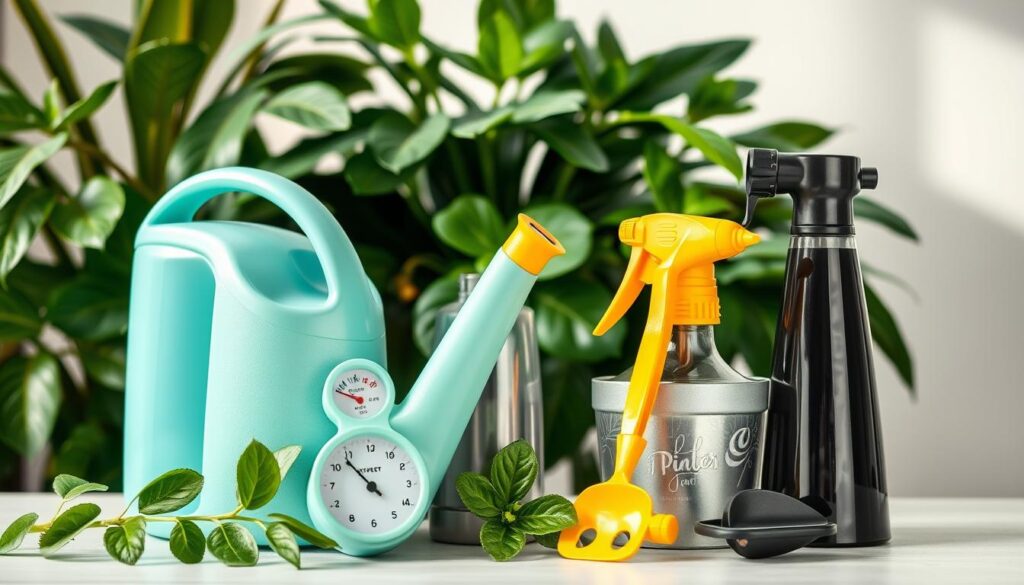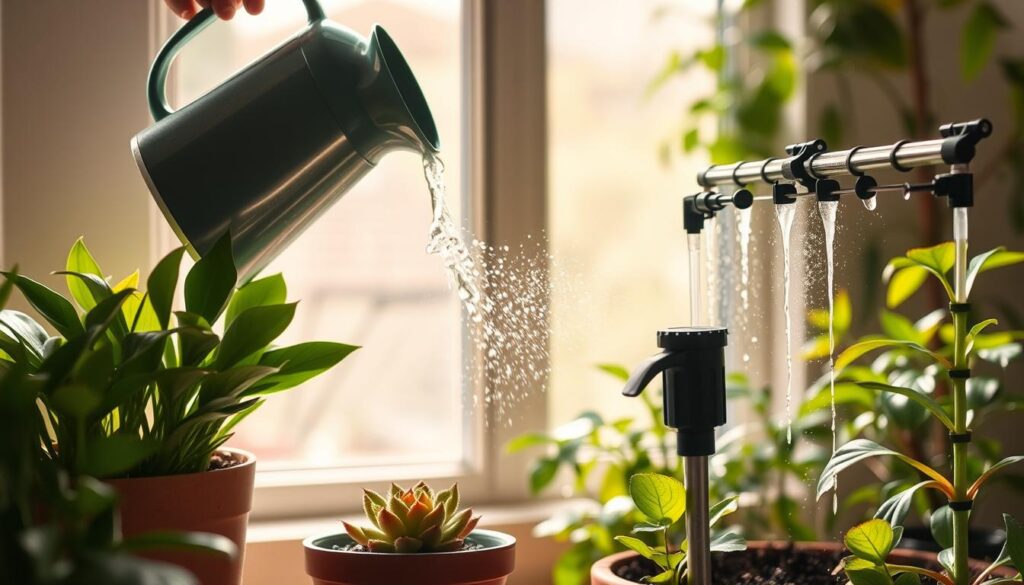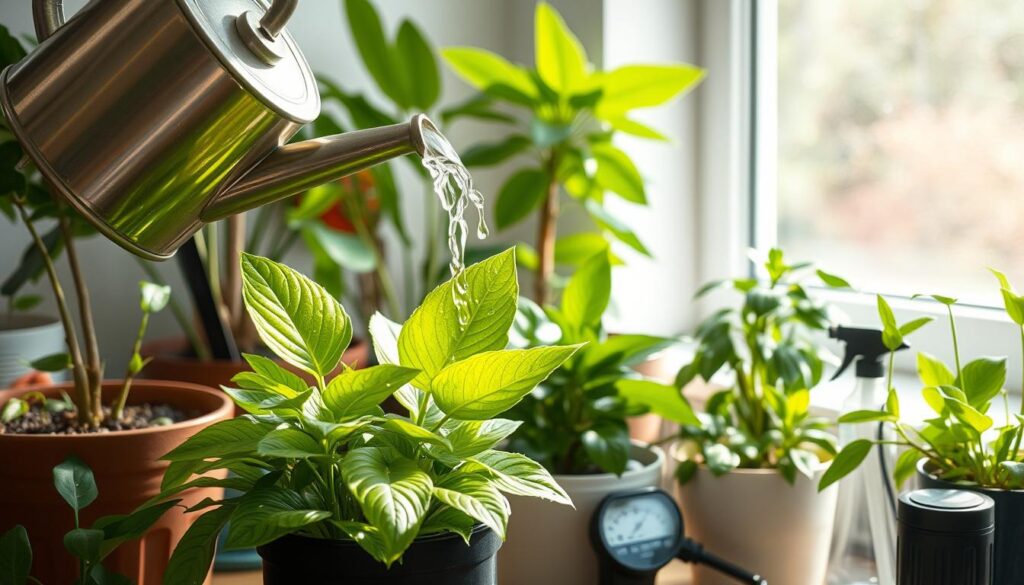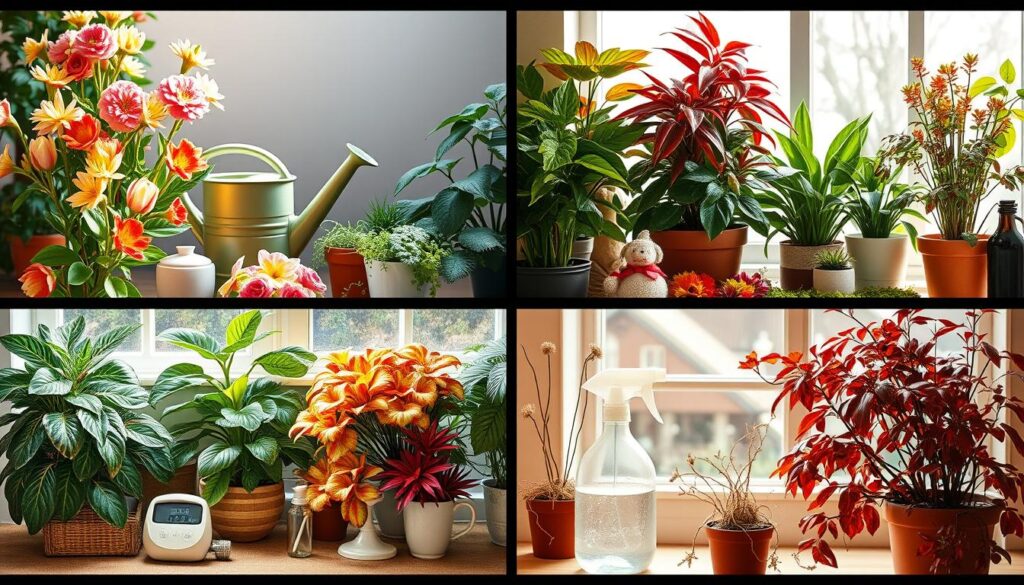Caring for indoor plants or Houseplant is all about finding the right balance. Watering is key to keeping them healthy and strong. This guide will help you learn how to water your plants well, whether you’re new to gardening or have lots of experience.
Water is vital for plants to grow and make food through photosynthesis. Knowing how much water your plants need is important. It helps avoid problems like too little or too much water.
We’ll look at different tools and methods for watering, from old-fashioned cans to new gadgets. You’ll discover how things like the weather, pot size, and plant type affect watering. This way, you can adjust your care to meet your plants’ specific needs.
Understanding the Importance of Proper Plant Watering
Watering your indoor plants right is key to their health and growth. Water helps plants grow by enabling photosynthesis and moving nutrients around. Giving your plants the right amount of water at the right time is crucial.
The Role of Water in Plant Growth
Water is essential for plant cells, keeping them moist for important functions. It keeps the plant’s structure strong, helps move nutrients, and controls temperature through transpiration.
Impact on Photosynthesis Process
Photosynthesis, where plants make food from sunlight, water, and carbon dioxide, relies on water. Proper watering gives plants the water they need for photosynthesis. This supports their growth and development.
Signs of Healthy Plant Hydration
Healthy plants have firm, upright leaves, grow steadily, and have moist soil. The finger dip test can show when it’s time to water by checking soil moisture.
“Proper watering is the foundation of healthy indoor plants. Understanding the role of water and recognising the signs of optimal hydration will help you nurture your greenery to thrive.”
Essential Watering Tools for Indoor Plants
Caring for indoor plants needs the right tools for their health and growth. You’ll need lightweight watering cans and moisture meters. These tools help keep your plants perfectly hydrated.
Indoor Watering Cans and Misters
Get a good watering can with a long spout. It helps you water the soil without getting the leaves wet. Also, a plant mister is key for spraying leaves, especially for plants that love humidity.
Moisture Meters and Indicators
A soil moisture meter is very useful. It checks if your plants’ soil is too wet or dry. Choose one that’s easy to read and shows when your plants need water.
Self-Watering Systems and Accessories
Self-watering systems, like spikes and matting, keep soil moist. They slowly release water as it’s needed. Use them with drainage trays to catch any extra water.

“Having the right watering tools on hand can make all the difference in keeping your indoor plants thriving and healthy.”
Good drainage is key for your plants. Make sure pots have holes and use trays for extra water. With these tools, you’ll give your plants the best care.
watering indoor plant Guide and tools
Proper watering is key for healthy indoor plants. This guide covers watering methods, tools, and techniques. We’ll look at the best ways to keep your plants hydrated.
Knowing your plants’ needs is crucial. Some, like ferns, need regular misting. Others, like succulents, need less water. Letting the soil dry out is important for these plants.
There are many watering tools available. Self-watering spikes and soil moisture meters make watering easier. These tools help keep your plants healthy by ensuring they get the right amount of water.
“Understanding the origin and environment of your houseplants is key to determining their water requirements and ensuring their survival.”
Choosing the right water is also important. Filtered water or rainwater is best. Tap water can be used but might have minerals that harm plants.
This guide and the tools we recommend will help you water your plants right. By following these tips, your indoor plants will flourish. They’ll add beauty and life to your home.
- Misting for tropical plants: Ferns, nerve plants, and micro orchids benefit from regular misting to maintain humidity levels.
- Sparing watering for dry-region plants: Succulents, cacti, and other drought-tolerant plants should be watered sparingly, allowing the soil to dry out before the next watering.
- Continuous root moisture for some plants: Certain plants, like carnivorous plants, require sitting in water continuously to keep their roots moist.
- Avoid water near the base for others: Plants like cacti, succulents, and cyclamens are prone to rotting at the base of the stems, so water should be avoided close to the base.
- Overhead watering for orchids: Orchids benefit from watering from above to avoid root rot, and the excess water should be drained thoroughly to prevent saturation.
By understanding your plants’ needs and using the right tools, you can create a beautiful indoor oasis. This oasis will bring joy and beauty to your home.
Different Watering Methods and Techniques
Watering your indoor plants is key to their health. There are many ways to do it right, like bottom watering, top watering, and the dip and drain method. Each method works best for different plants and situations.
Bottom Watering Method
The bottom watering method puts the pot in a water-filled container. The soil soaks up the water through the drainage holes. It’s great for plants that don’t like too much water, as it stops water from sitting on the soil.
Top Watering Approach
Top watering is the traditional way, where you water the soil directly. It’s good for many plants and lets you check the soil’s moisture easily. Make sure the water soaks in well and the soil doesn’t get too wet.
Dip and Drain Technique
The dip and drain method dips the pot in water for 10-15 minutes, then drains it. It’s perfect for plants that like moist soil, like some tropical ones. It makes sure the roots get enough water.
Each plant watering technique has its own benefits. The right method depends on your indoor plant and home conditions. Try different watering methods to find the best for your proper watering schedules and keep your plants happy.

“The key to successful indoor plant care is understanding your plant’s unique watering needs and adjusting your techniques accordingly.”
Understanding Your Plant’s Water Requirements
Knowing how much water your indoor plants need is key. Each plant has its own water needs, based on where it comes from. For example, tropical plants need more water than succulents and cacti.
The size of the pot, the soil type, and your home’s environment also play a part. Checking the soil moisture and watching your plants can help you find the right watering schedule.
- Beginner-friendly plants like Snake Plants, Pothos, ZZ Plants, Spider Plants, and Peace Lilies are great for newbies.
- Some plants love low light (like Snake Plants, ZZ Plants), while others need bright, indirect sunlight (like succulents).
- The “finger test” is a simple way to check if your plants need watering: just stick your finger into the soil up to the second knuckle. If it’s dry, it’s time to water.
Watching for signs of too little or too much water is important. Look out for wilted or yellow leaves, dry soil, or slow growth. Regular care, like removing dead leaves and trimming stems, also helps your plants stay healthy and look good.
“Growing plants is a learning process that requires patience and a willingness to learn from setbacks or mistakes. But the joy and serenity they bring to any space make it a worthwhile endeavour.”
By understanding your plant’s water needs and adjusting your watering schedule, you can help your indoor plants flourish. This way, they can keep your home feeling like a natural oasis.
The Best Water Types for Indoor Plants
Choosing the right water for your indoor plants is key to their health. Tap water might be easy to use, but it’s not always the best. Let’s look at the advantages of different water types and how they affect your plant care.
Filtered Water Benefits
Filtered water is a top pick for indoor plants. It gets rid of harmful chemicals and impurities. Tap water in the UK can be safe, but it might not be perfect for all plants.
Plants from rainforests might not like tap water’s minerals and chlorine. But desert plants, like cacti, are usually okay with it.
Rainwater Collection Tips
Collecting rainwater is a great way to hydrate your plants. Rainwater is soft and free from minerals and chemicals. To collect it, you can use a simple rain barrel or container.
Tap Water Considerations
If you use tap water, there are ways to make it better. Letting it sit in a jug overnight can get rid of chlorine. Using filter jugs can also remove impurities.
Watch your plants for signs of bad water quality. Look for limescale, yellow leaves, stunted growth, crispy edges, and brown new growth.
The best water for your plants depends on their needs and your tap water’s quality. Knowing the benefits of filtered, rainwater, and treated tap water helps your plants stay healthy.

Seasonal Changes in Watering Needs
As the seasons change, so do the watering needs of your indoor plants. It’s important to understand how growth and water needs change with the seasons. In autumn and winter, plants grow slower and need less water.
In winter, watering indoor plants should be cut back, especially by late November. Make sure the soil is dry by 50% to avoid too much water. Houseplants use less water in winter, so the soil may stay wetter for longer.
As spring and summer come, you’ll need to water more often. This is because plants grow faster in these seasons. Adjust your watering based on changes in humidity, temperature, and light.
- Decrease watering frequency in autumn and winter due to slower growth rates.
- Increase watering in spring and summer as plants enter active growth phases.
- Adjust watering based on seasonal changes in humidity, temperature, and light exposure.
“Proper seasonal care is essential for the long-term health and success of your indoor plants.”
By paying attention to your plants’ seasonal watering needs, you can keep them healthy all year. This approach is key to successful indoor gardening.

Signs of Improper Watering
It’s important to watch for signs of too much or too little water for your indoor plants. Spotting these signs helps you adjust your watering. This way, your plants can stay healthy and grow well.
Overwatering Indicators
Plants that get too much water often have yellow, mushy leaves. They might also wilt even when the soil is wet. The soil might look mouldy, and the pots can feel very heavy.
These signs mean the roots could be rotting. This is bad news for the plant. You need to fix this problem quickly to save it.
Underwatering Symptoms
Plants that don’t get enough water will droop and have crispy leaves. They might also grow very slowly. This shows they need more water to stay healthy.
Root Health Assessment
To check your plant’s roots, gently take it out of its pot. Look at the roots closely. Healthy roots are firm and light in colour.
But if the roots are dark and mushy, they’re rotting. Cut off the bad parts and put the plant in new soil. This fresh soil will help it recover.
FAQ
Why is proper watering important for indoor plants?
Water is key for plant growth and photosynthesis. It’s vital for keeping indoor plants healthy. Without it, plants can suffer from root rot or dehydration.
How can I tell if my indoor plants are properly hydrated?
Healthy plants show firm leaves, steady growth, and moist soil. The finger dip test is a good way to check soil moisture levels.
What are some essential watering tools for indoor plants?
Key tools include lightweight watering cans and misters for light spraying. Moisture meters help check soil dampness. Self-watering systems, like spikes and capillary matting, also keep moisture levels steady.
What are the different watering methods for indoor plants?
There are three main methods: bottom watering, top watering, and the dip and drain technique. Each suits different plants and situations.
How do I know how much water my indoor plants need?
Water needs vary by plant type, based on their natural habitats. Tropical plants need more water, while succulents and cacti prefer dry conditions. Pot size, soil type, and environment also play a role in watering frequency.
What type of water is best for indoor plants?
Rainwater and filtered water are best, as they’re free from harmful chemicals. Tap water can contain chlorine and fluoride, which harm some plants. Let tap water sit overnight to reduce chlorine levels.
Do indoor plant watering needs change with the seasons?
Yes, watering needs change with the seasons. Plants need less water in autumn and winter. Increase watering in spring and summer when plants grow faster. Adjust based on humidity, temperature, and light.
How can I tell if I’m over- or under-watering my indoor plants?
Overwatering shows as yellow leaves, wilting, and fungus gnats. Underwatering causes crisp, brown leaves and slow growth. Check roots by gently removing the plant; healthy roots are firm and light-coloured.
